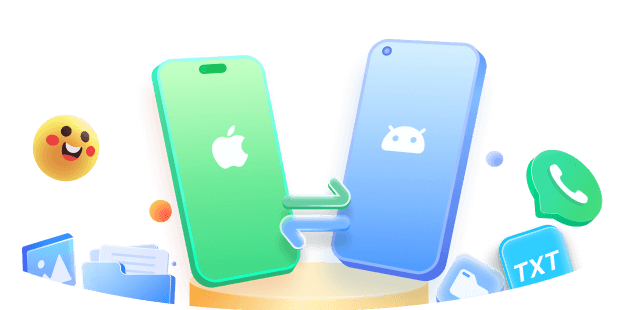It's indisputable that high-speed internet connectivity in this age is crucial, as many rely on it for seamless mobile networking and cellular technology. Ever since the introduction of the 5G networks, one of the most common questions from folks is, what is the Difference between 4G and 5G?
Both 4G and 5G are great networks, but when speaking of differences, there are many things to consider, including speed, frequency, latency, etc.
This 4G vs. 5G guide has covered the essential information you must know about the 4G and 5G networks based on various aspects. So, read on to find out what both network technologies offer.
Part 1: What is 4G and 5G?
Before we dive into discussing what 4G and 5G networks are, let's have a quick overview of the features each of these network generations has to offer users.
| Generation | Year | Feature |
| 4G (Fourth Generation) | The 2010s | ●Low cost per bit. ●High speed ●Easy switching ●Quick & easy access to the Internet, IM, social networks, streaming media, and video calling. ●Higher bandwidth ●It's faster than 3G |
| 5G (Fifth Generation) | The 2020s | ●Top-notch reliability. ●Provides seamless user experience for more devices besides mobile phones. ●Ultra-low latency ●Peak multi Gbps data speed. ●Huge network capacity. ●100 times better than 4G |
What is 4G?
Also known as Fourth Generation, 4G is a cellular network technology innovated in the 2010s to give users quicker and easier access to the internet on mobile phones, tablets, and laptops.
During the 4G era, LTE (Long Term Evolution) was introduced as a global standard for wireless broadband. And it brought about different versions of the 4G network, which includes the 4G LTE and the 4G LTE-Advanced.
The 4G LTE offers a typical download speed of Mbps and a theoretical download speed of 150Mbps, while 4G LTE-Advanced, on the other hand, could reach a typical download speed of 42Mbps and a theoretical download speed of 300Mbps. However, despite their incredible speed, the 4G network is no match compared to the 5G network. Read on to find out what 5G is.
What is 5G?
Developed by several companies that work in the mobile ecosystem, 5G is the next wireless standard. Although 4G opened new possibilities in mobile communication with its launch, 5G will go beyond the mobile realm and will be used for the IoT (the Internet of Things) while supporting countless other technologies that are unknown today.
Even in today's communication and networking realm, 5G will enhance the current broadband and mobile communication. That is to say, users will get a more immersive experience, like AR and VR technologies.
Part 2: Differences between 4G and 5G
Now you have a brief understanding of what 4G and 5G networks are, let's find out more about what differentiates 4G from 5G. We've explained these differences based on several factors, including speed, latency, and many others. So, keep reading to find out more.
1. 4G vs. 5G: Speed
Unsurprisingly, 5G is faster than 4G. But, some might ask, how fast? The table below will help you understand the speed, including both networks' max speed and real-life speed.
| Generation | Max Speed | Real Life Speed |
| 4G | 100Mbps | 34Mbps |
| 5G | 20Gbps | 50Mbps - 3Gbps |
5G is designed to offer better capacity than 4G, thus making more space for more users to use their devices with ultra-fast internet connectivity. As a result, it makes it easier and faster for folks to access social media, stream videos, browse the internet, and do other regular things, enabling the execution of more advanced operations.
2. 4G vs. 5G: Frequency
The modern communication and navigation system depends on radio waves, with bandwidth frequencies ranging from tens of kilohertz to 300 gigahertz.
The radio waves' bandwidth decides the network's distance and speed. For instance, low-frequency networks can cover longer distances, but their speed is slow, and vice versa. Therefore, each new generation of mobile networks comes with changes in the frequency band and operation modes.
| Generation | Type | Frequency |
| 4G | 4G LTE | 600 MHz to 2.5 GHz |
| 5G | Low-band | 600 MHz to 850 MHz |
| Mid-band | 2.3 GHz to 3.7 GHz | |
| C-band | 4GHz to 8GHz | |
| Millimeter-wave band | 25GHz to 39GHz |
4G networks use frequency bands and spectrum in 600 MHz, 700 MHz, 1.7/2.1 GHz, 2.3 GHz, and 2.5 GHz gaps.
FDD LTE and TDD LTE frequency bands in 4G are divided between primary and secondary users. Put it. Cellular network providers use FDD LTE bands. In contrast, TDD LTE bands are used by ISP or closed network providers.

5G, essentially uses the 25-39 GHz frequency band. But there are FOUR frequency bands in total, including;
- Low Band
The Low-band (600-850 MHz) is only moderately father than the 4G networks; as a result, most countries are avoiding the utilization of low-band altogether.
- Mid-range Band
The mid-range frequency band (2.5-3.7 GHz) delivers only a small range (so there will be more towers for optimum coverage). However, the download speed is higher than the 4G network's top download rate.
Also, the mid-band frequency band 5G coverage is suitable for densely-populated rural and mildly populated urban areas.
- C-band
The C-band frequency (4GHz-8GHz) is a type of radio spectrum that telecommunication industries utilize in enhancing the performance and reach of the 5G wireless network.
- Millimeter-wave band
At the same time, the high-band frequency band 25-39 GHz (also known as millimeter-wave) is expected to deliver up to 20Gbps speed (currently tested at 3Gbps).
To put this into perspective, the 5G network, at its highest frequency band, will deliver 20Gbps of speed, whereas the 4G network only provides the top downloading speed of 35Mbps.
3. 4G vs. 5G: Latency
Latency, in simple words, is the time it takes for a request to go from a client to a server and back to a client from the server; the more the distance, the more the latency.
| Generation | Current Latency | Potential Latency |
| 4G | 30-70 ms | 30-70 ms |
| 5G | 5-20 ms | 1 ms |
As you can see from the table above, the 4G network still has more latency compared to 5G. This indicates that 5G phones are more responsive for simultaneously making video calls and playing games, grainy video quality, etc.
In all, the lower the latency, the better. So, if a 5G network could have a latency of 1ms, that would be incredibly amazing, as it'll be capable of supporting more complex systems for automated cars and other big factories.
4G vs. 5G: Network Architecture
The architecture and connected applications of 4G and 5G make them different, i.e., one with better speed, low latency, and advanced capabilities.
Put, 4G LTE architecture has two nodes, the RAN and eNodeB. And these two nodes are usually close together, often at the base or near the cell tower, whereas the EPC (Evolved Packet Core) is further away from the eNodeB. The problem is that this makes it almost impossible to achieve end-to-end connectivity with high speed and low latency.

As can be seen in the diagram, the UE in the 4G network architecture connects over the LTE (Long-Term Evolution) to the Evolved Packet Core and then the external network. Finally, the eNodeB separates the user and network management traffic and feeds the request into the EPC.
At the same time, 5G runs on the 3rd Generation Partnership Project (3GPP) new standards. The functions are separated depending on the service, using numerous techniques like Network Function Virtualization and Software Defined Networking.

As evident from the block diagram, the underlying core architecture of 5G is complex, but this complexity ensures a higher speed and low latency.
There are different network functions in 5G, which means there are no one-size-fits-all functions like in 4G LTE networks. The user request in 5G still starts as a single-entry point like in 4G LTE networks.
However, based on the user-provided service, the Access and Mobility Management Function selects the management function, authenticates it, and transports the IP back to the external networks.
4G vs. 5G: Coverage

4G covers about 85% of the global population, according to recent data from Erricson. In contrast, 5G spans only 25% of the total global population and is forecasted to cover about 75% worldwide by 2027.
According to Verizon, more than 2700 cities in the US have 5G coverage. In addition, 5G is expected to reach 1 billion users this year, just 3.5 years after its launch.
Part 3: FAQs
1. What are the disadvantages of 5G over 4G?
5G has high speed, but its presence is limited only to the big cities. Moreover, experts estimate that 5G global coverage would take many years, whereas 4G already spans 85% of the population.
5G is also estimated to have weaker uploading speeds. Moreover, many experts believe that the 5G spectrum can interfere with flight operations. Not to mention, 5G is already infamous for inflicting mobile battery damage.
2. Do I need a new phone if I want 5G?
Yes, the hardware needed to support 5G is only available in 5G phones. The good thing is all the US flagship sells 5G phones today. If you plan to buy a new 5G phone, you can use MobileTrans to transfer data from your old phone to the new one.
3. Can I use the 4G network on a 5G phone?
Yes, it supports both 4G and 5G. However, a 4G-powered SIM will not allow you to leverage the full capabilities of 5G. And you will need a 5G SIM card to enjoy 5G connectivity and transmission speed.
4. Does 5G use more data than 4G?
No, 5G does not consume more data than 4G. Instead, it consumes the same amount of data a 4G network requires to complete an operation.
However, keep in mind that since 5G can execute bigger operations faster, you'll tend to carry out tasks that a 4G network might take time to complete. For example, 5K will play a 4K video or download it faster than 4G. So, there's a high probability of 5G using up data faster compared to 4G.
Final Thoughts
Over the years, mankind has witnessed a continuous upgrade in the wireless infrastructure of the cellular industry, from 1G to 2G, 3G, 4G, and now 5G.
At this point, you should already have a brief understanding of how 4G and 5G networks work, be it their frequency, speed, network architecture, etc.
However, in all, we put it simply that the new 5G network is the one that will enhance our connected lives, making it easier for one to execute different day-to-day activities fast.
MobileTrans - Best Android to iOS transfer tool
The 1-click solution to transfer data from Android to iPhone. Supports transferring of contacts, photos, music, videos, calendar, and more.
New Trendings
Top Stories
All Categories










Caroline Laurent
staff Editor